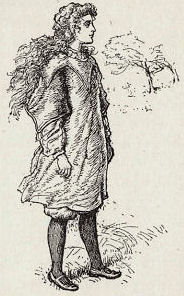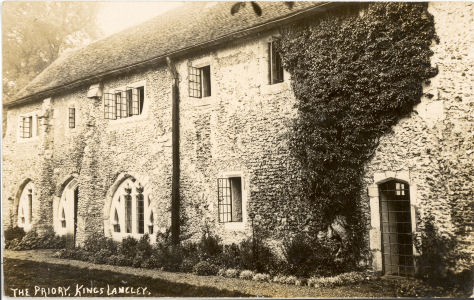|
Coombe Hill School, Kings Langley Formerly Coombe Hill School, East Grinstead & Coombe Hill School, Westerham, Kent Later Priory School, Kings Langley |
|
Coombe Hill School, Kings Langley Priory, Herts |
||
|
Coombe Hill School, Kings Langley, Herts Publisher P. A. Buchanan & Co, Croydom, No 11272 The card caries the following Xmas message from the Headmistresses |
||
|
|
I acquired the above post card because it is a datable Hertfordshire school picture by P.A. Buchanan which must have been produced in the period 1910-14. However it turns out that the school was very progressive and had an interesting history which can be best understood in terms of the lives of the co-principals, Miss Hannah Clark and Miss Margaret F Cross.
In 1861 James and Maria Clark were living at Highham, Norfolk with children Maria (18), Hannah (16), Ellen (11), Alice (10), Alfred James (7) and Catherine (5). James was recorded as being a cashier in an insurance office and a local Methodist preacher while daughter Maria was described as a "teacher at home". Ten years later James (now Managing Clark of Norwich Union Fire Office) and his wife lived at the Chantry, St Stephens, Norwich. In the household were Hannah (schoolmistress), Alice (teacher working with Hannah) and young Catherine.
In 1881 the sisters Maria Clark (38), Hannah Clark (36) and Catherine Clark (25) ran a school with 12 boarders at Surrey Court, Norwich St Stephen, Norfolk.
Ten years later Maria and Catherine were still running the school at Surrey Court, Norwich. Hannah Clarke was now running a small school (with 8 boarders aged between 11 & 17) at 6, Suffield Park, Overstrand, Norfolk and Margaret F Cross was teacher of music & mathematics.
By 1899 Hannah Clark was running a ladies school in Coombe Hill House, East Grinstead, Sussex and the 1901 census it was referred to as Coombe Hill School . The census listed only one other teacher - Miss Alice Hasthorpe was described as a Gymnastics Teacher. Interestingly there was 69 year old boarder, Norman Cross, a retired farmer who turns out to be the father of Margaret Cross.
By the summer of 1902 the school had moved to Westerham, and the following report describes its approach to Nature Studies (Nature Studies Exhibition 1902)
At the Coombe Hill School, Westerham, the object is : —
*' to conduct the Nature-study of the school in such a way as to arouse interest in all natural phenomena and to foster the spirit of enquiry.
" The greater part of the work is carried on, as a matter of course, out-of-doors, and is therefore seasonal, for the children are taken direct to Nature, and are led to observe for themselves the modes of growth and the habits of plants; to follow the life-history of animal organisms; to note the changes wrought, as the year advances, in landscapes familiar to them ; and to note the daily and seasonal alterations in the face of the heavens.
"The use of note-books is not adopted, as it tends to divert the mind from the subject in hand; and as the children are not likely to forget their own discoveries, notes are not needed, at any rate during the lesson. Wherever direct information is given by the teacher, the faculty of association can be relied on to give the necessary stimulus to memory. It has seemed to be worse than useless to systematize over-much in these studies. One has to take for subject-matter such objects as are at hand. The general direction of a term's or a year's course of study can be planned, and it is well, when possible, to explain beforehand what is to be noticed in a given (outdoor) lesson; but the children's taste, and enthusiasm, and wonderful quick observation carry them beyond this, and much more is discovered, as a rule, than was expected at the outset.
" The exercise-books contain descriptions (written spontaneously by the children) of some of the work of the present year, while the diagrams test the accuracy of their observations and, in most cases, the retentiveness of their memory.
** Brush-work is resorted to as a simple and effective means of representing the beauty of which they become conscious in the course of their study, and the specimens in the exhibition were entirely their own work, and are treated by the brush alone. The woodwork (nesting-boxes, &c. ) and baskets were included in order to show that the children (girls and boys) are encouraged to make as much as possible of the apparatus required for their Nature-study."
At Coombe Hill School, Westerham, Kent, the dress takes the form of a tunic with wide sleeves which come to the elbow. It is put over the head and has no fastenings. It is modelled upon the Djibah of the Dervishes, and is made of soft woollen material of a fawn colour. The yoke is of green embroidery and the underslip is tussore. Under the tunic a blouse of white silk is worn, and the sleeves, of course, show from the elbow downwards. The rest of the costume consists of cloth knickerbockers and stockings, with sandals or shoes that are made to the shape of the foot. This dress is worn on all occasions at school, and the girls are very proud of it.
Was this uniform worn at Kings Langley?
In 1910 Hannah Clark, of Coombe Hill School, Westeram, wrote a letter to The New Age, Volime 6, No 21, (24 March 1910). She started; As an educationist of many years’ standing, and one who thoroughly endorses the principle that “ the school should exist for the child,” I have read with much interest Mr. Allen Upward’s “Practical Prospectus” in last week’s NEW AGE. ... and made some progressive suggestions concluding Thus the normal boy would become the Superman, and the fond hope of the parent would be realised - a hope, by the way, not unfounded, although so often illusory; for who does not realise that the child of a pre-school age is as far superior in originality and brilliancy to the average school-boy as the Superman to the normal man?
In fact, by this date a move to the Priory in Kings Langley was already being prepared. The property had been acquired in 1909 and Margaret Cross supervised the necessary building work. Hannah and Margaret were keen to adopt the educational principles of Madame Montassori and the school opened in Kings Langley in 1910. The 1911 census records the following.
|
As Margaret is listed as head of household, and co-principal, it may well be that the move was funded by her father. The school also advertised for pupils as the following advert from The Herald of the Golden Age, Volume 14, July 1911 shows
The cover of the magazine, with its subtitle "and British Health Review", and the articles it contains, undoubtedly reflects at least some of the views of the joint headmistresses, which is presumably why they advertised in this magazine For instance the following editorial comment under the heading "The Voice of Nature" seems particularly relevant:
It is a noteworthy fact that although children are frequently caught purloining fruit from orchards (so strong is their desire for it) we never hear of small boys stealing chops or steaks from the butchers' shops. Here Nature speaks with no uncertain voice concerning our natural food. The instinct of the children should be regarded, and they should be allowed often to make their meals consist of nuts, bananas, and other products of the orchard and garden, with good brown bread and butter. I know of many families in which this plan is adopted, and it nearly always seems to result in health, good temper and vigorous constitutions.
In 1915 Miss Burton joined the school in 1915. I have not found out her Christian name and wonder if she was Constance M Burton, who was a pupil at Coombe House School, East Grinstead, in 1901, or Winifred Alice Burton, (her sister?) who was in the Norwich School run by Hannah's sisters in Norwich in 1891. Can anyone help on this?
In December 1921 Margaret Cross attended a course given by Dr. Rudolph Steiner, who visited the school in April 1922, and the schools approach included bio-dynamic gardening and eurythmy. Hannah Clark died in 1934 and Margaret Cross continued what was now known as the Priory School until 1955, dying in 1962, nursed by Miss Burton.
In 1949 the Rudolph Steiner "New School" moved onto the adjacent Priory House site, and the old Priory building has been incorporated into the current school.
For a little more information from 1915 onwards see Education in Dacorum.
Paul Jeffree (paul @t panduj.plus.com) writes: I was a pupil at Kings Langley Priory School from about 1942 till 1948, so was there as it expanded to include first the neighbouring property to the south (whose name I forget), and then 'Friarswood' to the west which was used as a boarding hostel.
Of course in those days we didn't refer to our betters by Christian name, so only knew the principals as Miss Cross and Miss Burton. However, I seem to recall that Miss Burton's Christian name was Hilda, but couldn't swear to it.
My class teacher was Miss Compton Burnett (Vera). Her sister also taught there and they lived in a small cottage on the hill above Berkhamsted. A third sister was Ivy Compton Burnett, the writer.
Before the school expanded Miss Cross was the de-facto head. With the expansion the College of Teachers assumed more control, which led to a split when they wished to take over the original school property. My father was involved in the legal arguments and helped Miss Cross retain that property. So the 'New School' was formed next door, without Misses Cross and Burton, and I left (happily not under a cloud!). I returned for a short spell of private tuition (Latin!) in '53 from Miss Cross, but had no further contact with either school.
I was most interested to come upon the earlier history of the school and also your note of date when Miss Cross died, so soon after I last met her. Many thanks.
November 2011 Page created
January 2012 Pail's memories added








